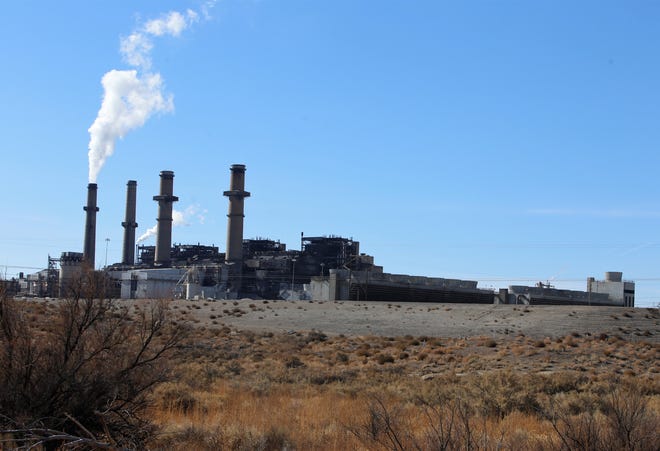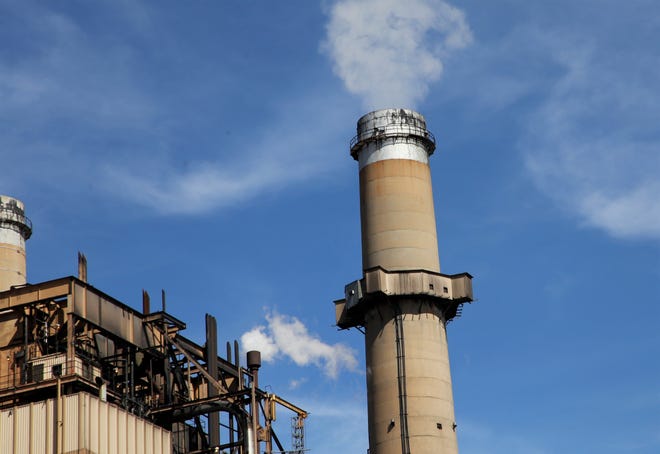New report highlights economic benefits of carbon capture retrofit of San Juan power plant
Deputy energy secretary presents report in Albuquerque
- A copy of the report can be viewed online at misi-net.com.
- The more than 100-page report was compiled by Management Information Services Inc.
- The report highlights that a carbon capture retrofit will create significantly more jobs than PNM’s replacement power scenario.
AZTEC — Retrofitting the San Juan Generating Station with carbon capture technology will provide more tax revenue and more jobs than replacing the power plant with renewable energy sources, according to a report commissioned by the U.S. Department of Energy.
The report largely reiterates points that Enchant Energy and its supporters have been making since they brought the proposal forward in 2019 in an effort to keep the San Juan Generating Station open after 2022. A copy of the report can be viewed online at misi-net.com.
Deputy Secretary of Energy Mark Menezes presented the report on Oct. 5 along with Enchant Energy representatives and their partners, including the City of Farmington, during an event in Albuquerque that was streamed on the Enchant Energy Facebook page.
“(Carbon Capture Utilization and Storage) is an incredible example of innovation,” Menezes said. “One that has the potential to drive emissions down to zero, making fossil fuels as emissions free as renewables.”
More:Enchant Energy CEO addresses Petra Nova closure implications for San Juan project
Carbon capture proponents claim that the technology can capture 95% or more of the carbon dioxide emissions from the flue gas of a coal-fired power plant. However, that does not take into account emissions from mining operations or emissions from oil produced using carbon dioxide captured from the plant to force oil out of the ground in enhanced oil recovery.
"CCUS is a technology just waiting to change this nation and the world," Menezes said. "And when it does, it will be nothing short of phenomenal."

The more than 100-page report compiled by Management Information Services Inc. compared the proposed carbon capture retrofit to a replacement power scenario proposed by the power plant’s majority owner and operator, the Public Service Company of New Mexico. MISI chose to compare Enchant Energy’s proposed retrofit to PNM’s scenario three, which included both battery storage and renewable sources.
Enchant Energy and the City of Farmington are in talks with PNM and the other owners of the San Juan Generating Station to have the ownership transferred.
The replacement power proposal only looked at replacing PNM’s share of the electricity generated by the San Juan Generating Station. It also was ultimately rejected by the New Mexico Public Regulation Commission, which approved a 100% renewable energy replacement power scenario proposed by Coalition for Clean Affordable Energy. Notably, the CCAE proposal included more solar energy development in the Central Consolidated School District in San Juan County.
Others are reading:San Juan Generating Station renewable energy plan gets approval from PRC
"I think the theme of the report would have been consistent even if it was compared to the other scenario that was approved by the PRC," said Enchant Energy CEO Cindy Crane.
The report highlights that a carbon capture retrofit will create significantly more jobs than PNM’s replacement power scenario while also generating more tax revenue that will help both San Juan County and CCSD.
"It really just reaffirmed what we have been saying," said Farmington Mayor Nate Duckett.
Duckett said the report does provide a more in-depth look at the benefits that a carbon capture retrofit would provide to Navajo Nation.
"It's nice to have some reinforcing, independent work come to the surface," Crane said.

One major emphasis in the report is job creation. It states that the carbon capture proposal would create 136 jobs per megawatt while PNM's renewables and battery storage scenario would lead to a little more than five jobs per megawatt.
This is in part because coal is labor intensive compared to alternatives like solar or even natural gas.
"Those jobs have names," said Farmington Electric Utility System Director Hank Adair. "They have smiles. They have families. And we love them."
More:San Juan Generating Station renewable energy plan gets approval from PRC
Duckett said the carbon capture project saves 1,500 jobs and allows for economic development while also benefiting San Juan College and the Navajo Nation. The college has partnered with Enchant Energy and Farmington to develop a carbon capture workforce and many of the San Juan Generating Station employees are Navajo.
The report states that the carbon capture retrofit project will create thousands of more jobs for Navajo Nation workers than the PNM scenario.
"It's a win for the economy, it's a win for the environment and it's a win for the future of our city, of our community," Duckett said. "It's a win for our region."

Duckett said independent reports like the DOE report released this week and a report released by Los Alamos National Laboratories last year have emphasized that projects like a carbon capture retrofit of San Juan Generating Station are needed worldwide to seriously reduce carbon dioxide emissions without destroying the economies of communities that rely on fossil fuel industries.
"I think Farmington represents a number of energy communities in rural America that are being harmed right now by this policy of just getting rid of carbon power as opposed to providing bridge technology that takes us to the next level," Duckett said.
Who completed the study?
MISI is a Washington D.C. based firm that provides management consulting and litigation support. In the past few years, it has completed other studies that tout the economic benefits of proposed carbon capture retrofits of coal-fired power plants including the Comanche Generating Station in Colorado.

Past reports completed by MISI have also downplayed or denied the impacts of anthropogenic emissions, or emissions caused by human activities, on climate change, include a report about the social cost of carbon that the firm’s president presented in December 2014 to the U.S. Energy Association. In the presentation that can be found on MISI’s website, it states in bold letters that there is “no convincing evidence that anthropogenic global warming (AGW) will produce catastrophic climate changes.”
The 2014 report was prepared on behalf of the American Coalition for Clean Coal Energy. On that same slide, the presentation states that the world has not been getting warmer despite increased carbon dioxide emissions.

More recent reports the firm has completed regarding the development of carbon capture, utilization and storage have highlighted the technology as a way to address climate change. It also released a report in June estimating that the Green New Deal — a proposal that would move the United States away from fossil fuel energy — could create more than 18 million jobs nationwide.
The report evaluating the San Juan Generating Station only mentions climate change once. It states that carbon capture is the centerpiece of the U.S. Department of Energy’s strategy to address climate change and that the San Juan Generating Station project will be the largest deployment of the technology to date.

Hannah Grover covers government for The Daily Times. She can be reached at 505-564-4652 or via email at hgrover@daily-times.com.
Support local journalism with a digital subscription: http://bit.ly/2I6TU0e